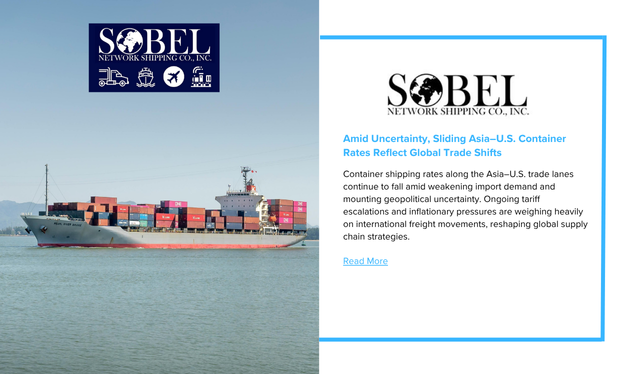Container shipping rates along the Asia–U.S. trade lanes continue to fall amid weakening import demand and mounting geopolitical uncertainty. Ongoing tariff escalations and inflationary pressures are weighing heavily on international freight movements, reshaping global supply chain strategies.
Recent data shows that Asia–U.S. West Coast spot rates fell 24% to $2,369 per forty-foot equivalent unit (FEU), while East Coast rates dropped by 5% to $4,888 per FEU. These shifts come despite persistent global disruptions, including instability in the Suez Canal and tariff battles between major trade blocs.
Freight analysts attribute the latest downward trend to the expiration of preemptive stockpiling strategies. Many importers had frontloaded goods earlier this year to sidestep anticipated tariffs and delays, but that buffer is now fading. As of June, inflation in the U.S. has ticked up by 2.7%, with tariff-induced costs beginning to flow downstream to consumers and businesses.
Trade Tensions Continue to Influence Global Flows
The European Union, in response to the U.S. administration’s proposed 30% tariffs on imports from August 1, has prepared a countermeasure targeting $84 billion worth of U.S. goods. However, Brussels is delaying its implementation in hopes of reaching a last-minute agreement.
As trade battles escalate, global shipping patterns are shifting. While Asia-to-Americas rates slide, Asia–Northern Europe lanes saw a 4% increase in FEU prices, climbing to $3,509, as exporters seek alternatives to the American market. Similarly, Asia–Mediterranean rates dipped modestly by 4% to $3,802 per FEU.
Carriers Respond with Capacity Cuts
To counter the slump in demand, shipping lines have cut trans-Pacific capacity by nearly 25%, aiming to bring supply back in line and preserve rate stability. This adjustment is vital for maintaining profitability as volumes soften and price pressures mount.
Broader Implications and Strategic Shifts
In parallel, major players in the logistics space are doubling down on infrastructure investments outside traditional trade routes. For example, Syria’s $800 million agreement with UAE-based DP World to upgrade the Tartous port marks a growing trend: logistics companies positioning for long-term gains in emerging or post-sanction markets.
While freight rates may continue to fluctuate, the broader message is clear: the global shipping ecosystem is undergoing a realignment driven by tariffs, inflation, and changing market demand.


